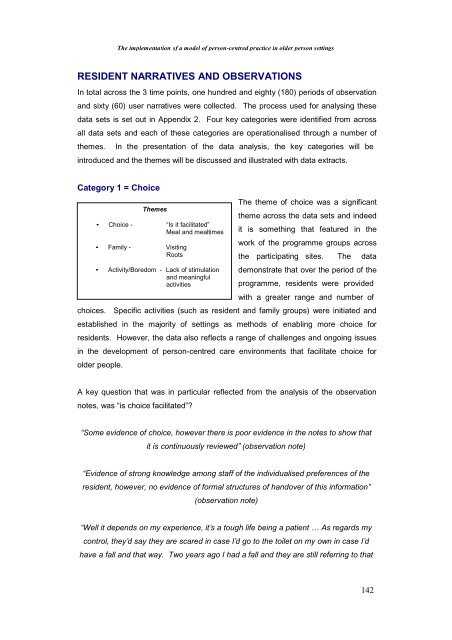The Implementation of a Model of Person-Centred Practice In Older ...
The Implementation of a Model of Person-Centred Practice In Older ...
The Implementation of a Model of Person-Centred Practice In Older ...
Create successful ePaper yourself
Turn your PDF publications into a flip-book with our unique Google optimized e-Paper software.
<strong>The</strong> implementation <strong>of</strong> a model <strong>of</strong> person-centred practice in older person settings<br />
RESIDENT NARRATIVES AND OBSERVATIONS<br />
<strong>In</strong> total across the 3 time points, one hundred and eighty (180) periods <strong>of</strong> observation<br />
and sixty (60) user narratives were collected. <strong>The</strong> process used for analysing these<br />
data sets is set out in Appendix 2. Four key categories were identified from across<br />
all data sets and each <strong>of</strong> these categories are operationalised through a number <strong>of</strong><br />
themes. <strong>In</strong> the presentation <strong>of</strong> the data analysis, the key categories will be<br />
introduced and the themes will be discussed and illustrated with data extracts.<br />
Category 1 = Choice<br />
<strong>The</strong>mes<br />
• Choice - “Is it facilitated”<br />
Meal and mealtimes<br />
• Family - Visiting<br />
Roots<br />
• Activity/Boredom - Lack <strong>of</strong> stimulation<br />
and meaningful<br />
activities<br />
<strong>The</strong> theme <strong>of</strong> choice was a significant<br />
theme across the data sets and indeed<br />
it is something that featured in the<br />
work <strong>of</strong> the programme groups across<br />
the participating sites. <strong>The</strong> data<br />
demonstrate that over the period <strong>of</strong> the<br />
programme, residents were provided<br />
with a greater range and number <strong>of</strong><br />
choices. Specific activities (such as resident and family groups) were initiated and<br />
established in the majority <strong>of</strong> settings as methods <strong>of</strong> enabling more choice for<br />
residents. However, the data also reflects a range <strong>of</strong> challenges and ongoing issues<br />
in the development <strong>of</strong> person-centred care environments that facilitate choice for<br />
older people.<br />
A key question that was in particular reflected from the analysis <strong>of</strong> the observation<br />
notes, was “is choice facilitated”?<br />
“Some evidence <strong>of</strong> choice, however there is poor evidence in the notes to show that<br />
it is continuously reviewed” (observation note)<br />
“Evidence <strong>of</strong> strong knowledge among staff <strong>of</strong> the individualised preferences <strong>of</strong> the<br />
resident, however, no evidence <strong>of</strong> formal structures <strong>of</strong> handover <strong>of</strong> this information”<br />
(observation note)<br />
“Well it depends on my experience, it’s a tough life being a patient … As regards my<br />
control, they’d say they are scared in case I’d go to the toilet on my own in case I’d<br />
have a fall and that way. Two years ago I had a fall and they are still referring to that<br />
142
















